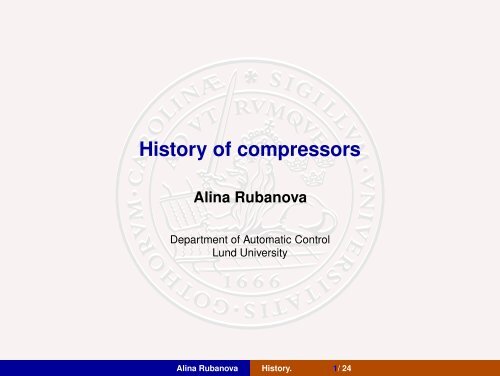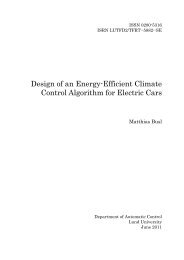History of compressors - Automatic Control
History of compressors - Automatic Control
History of compressors - Automatic Control
Create successful ePaper yourself
Turn your PDF publications into a flip-book with our unique Google optimized e-Paper software.
<strong>History</strong> <strong>of</strong> <strong>compressors</strong><br />
Alina Rubanova<br />
Department <strong>of</strong> <strong>Automatic</strong> <strong>Control</strong><br />
Lund University<br />
Alina Rubanova <strong>History</strong>. 1/ 24
Earliest history<br />
Outline <strong>of</strong> the Presentation<br />
First steps to the mechanical <strong>compressors</strong><br />
<strong>History</strong> <strong>of</strong> the <strong>compressors</strong> control<br />
Alina Rubanova <strong>History</strong>. 2/ 24
Earliest history<br />
The first air <strong>compressors</strong> weren’t machines, but human lungs:<br />
Primitive people blew on cinders to create a fire. We now know<br />
that healthy lungs can exert pressure <strong>of</strong> 0.02 to 0.08 bar<br />
Figure: The human air-compressor<br />
Alina Rubanova <strong>History</strong>. 3/ 24
Earliest history<br />
As people began to melt metals such as gold, copper, tin and<br />
lead, higher temperatures were needed, and a more powerful<br />
compressor was required.<br />
Figure: The usage <strong>of</strong> the compressed air<br />
Alina Rubanova <strong>History</strong>. 4/ 24
Earliest history<br />
Egyptian and Sumerian metallurgists used the wind, then<br />
blowpipes for their work.<br />
The first mechanical compressor, the hand-operated bellows,<br />
emerged soon after, and in 1500 B.C. the more efficient foot<br />
bellows came into use.<br />
Figure: The usage <strong>of</strong> the compressed air<br />
Alina Rubanova <strong>History</strong>. 5/ 24
PSfr<br />
Earliest history<br />
Figure: Ctesibius <strong>of</strong> Alexandria (c. 285-222 BC)<br />
The discovery <strong>of</strong> the elasticity <strong>of</strong> air is attributed to Ctesibius, as<br />
is the invention <strong>of</strong> several devices using compressed air,<br />
including force pumps and an air-powered catapult.<br />
Ctesibius’ writings have not survived, and his inventions are<br />
known only from references to them by Vitruvius and Hero <strong>of</strong><br />
Alexandria, but he laid the foundations for the engineering<br />
tradition that culminated in the works <strong>of</strong> Hero <strong>of</strong> Alexandria<br />
and <strong>of</strong> Philo <strong>of</strong> Byzantium.<br />
Alina Rubanova <strong>History</strong>. 6/ 24
Earliest history<br />
Figure: Hero (or Heron) <strong>of</strong> Alexandria 10 AD)<br />
Heron designed an automatic temple door opener, which used<br />
heat and pneumatics to open a set <strong>of</strong> temple doors.<br />
Alina Rubanova <strong>History</strong>. 7/ 24
Earliest history<br />
Figure: Hero (or Heron) <strong>of</strong> Alexandria 10 AD)<br />
Alina Rubanova <strong>History</strong>. 8/ 24
Earliest history<br />
Movements based on the wheel with the blades in some<br />
naturally fluid area (like wind or water).<br />
Figure: Water-powered blowing- engine <strong>of</strong> the 13-th century. China.<br />
Alina Rubanova <strong>History</strong>. 9/ 24
First steps to the mechanical <strong>compressors</strong><br />
Figure: John Smeaton. Born 8 June 1724 (1724-06-08), England<br />
In 1762, John Smeaton, the first pr<strong>of</strong>essional engineer, built a<br />
water wheel-driven blowing cylinder that began to replace the<br />
bellows.<br />
Alina Rubanova <strong>History</strong>. 10/ 24
First steps to the mechanical <strong>compressors</strong><br />
Figure: John Wilkinson. Born 1728, England<br />
Inventor John Wilkinson introduced an efficient blasting<br />
machine in England in 1776; the machine was an early<br />
prototype for all mechanical <strong>compressors</strong>.<br />
Alina Rubanova <strong>History</strong>. 11/ 24
First steps to the mechanical <strong>compressors</strong><br />
Alina Rubanova <strong>History</strong>. 12/ 24
First steps to the mechanical <strong>compressors</strong><br />
The basic principle is the same and without the primitive air<br />
<strong>compressors</strong>, civilization would not have evolved as fast it has.<br />
It wasn’t until later in history that it became possible to<br />
compress air using mechanical methods. In the past, only<br />
human and animal power was possible to power crude air<br />
<strong>compressors</strong> and this severely limited the utility <strong>of</strong> these<br />
primitive devices. With the industrial revolution, the<br />
mechanical compressor was born. Engines running from<br />
steam power became the first method to power these<br />
<strong>compressors</strong>. One <strong>of</strong> the first uses <strong>of</strong> a steam powered<br />
pneumatic-compressor was in underwater diving equipment<br />
Alina Rubanova <strong>History</strong>. 13/ 24
The main types <strong>of</strong> gas <strong>compressors</strong><br />
Alina Rubanova <strong>History</strong>. 14/ 24
Axial gas <strong>compressors</strong><br />
Early axial <strong>compressors</strong> <strong>of</strong>fered poor efficiency, so poor that in<br />
the early 1920s a number <strong>of</strong> papers claimed that a practical<br />
jet engine would be impossible to construct.<br />
Alina Rubanova <strong>History</strong>. 15/ 24
Axial gas <strong>compressors</strong><br />
Things changed after A. A. Griffith published a seminal paper<br />
in 1926, noting that the reason for the poor performance was<br />
that existing <strong>compressors</strong> used flat blades and were essentially<br />
"flying stalled". He showed that the use <strong>of</strong> airfoils instead <strong>of</strong> the<br />
flat blades would increase efficiency to the point where a<br />
practical jet engine was a real possibility. He concluded the<br />
paper with a basic diagram <strong>of</strong> such an engine, which included a<br />
second turbine that was used to power a propeller.<br />
Alina Rubanova <strong>History</strong>. 16/ 24
Three-state Moore-Greitzer compressor model<br />
Axial <strong>compressors</strong> are rotating, airfoil-based <strong>compressors</strong> in<br />
which the working fluid principally flows parallel to the axis <strong>of</strong><br />
rotation.<br />
Alina Rubanova <strong>History</strong>. 17/ 24
Difficulties:<br />
unstable dynamics<br />
Problem definition<br />
non-globally Lipschitz (cubic) nonlinearity<br />
not stabilizable with static output feedback<br />
Alina Rubanova <strong>History</strong>. 18/ 24
Three-state Moore-Greitzer compressor model<br />
d<br />
dt φ=−ψ+3<br />
φ)3<br />
φ+1−(1+ −3R(1+ φ)<br />
2 2<br />
d 1<br />
ψ=<br />
dt β2(φ−u) d<br />
dt R=−σR2 − σR(2φ+ φ 2 ),R≥0<br />
y= ψ<br />
here φ and ψ have the physical meaning being deviations <strong>of</strong> the<br />
averaged flow and the pressure from their nominal mean<br />
values, respectively.<br />
The stall R cannot be measured and used for feedback design.<br />
Alina Rubanova <strong>History</strong>. 19/ 24<br />
(1)
Preliminaries. Previous Research<br />
Previous Research:<br />
F.K.Moore, and, E.M.Greitzer<br />
- A theory <strong>of</strong> post-stall transients in axial compressor<br />
systems. 1986<br />
- Surge and rotating stall in axial flow <strong>compressors</strong> 1976<br />
J.D. Paduano<br />
- Compression system stability and active control. 2001<br />
M. Arcak and P.V. Kokotovic<br />
- Nonlinear observers: a circle criterion design and robustness<br />
analysis. 2001<br />
A.S. Shiriaev<br />
- Functional analysis <strong>of</strong> the constraints and conditions.<br />
J.T. Gravdahl<br />
- Drive torque actuation in active surge control <strong>of</strong> centrifugal<br />
<strong>compressors</strong><br />
Alina Rubanova <strong>History</strong>. 20/ 24
Previous Research<br />
Alina Rubanova <strong>History</strong>. 21/ 24
Possibilities <strong>of</strong> computer technology<br />
Alina Rubanova <strong>History</strong>. 22/ 24
Futute <strong>of</strong> <strong>compressors</strong> control<br />
Output Feedback <strong>Control</strong><br />
Alina Rubanova <strong>History</strong>. 23/ 24
Thank YOU!<br />
Alina Rubanova <strong>History</strong>. 24/ 24














